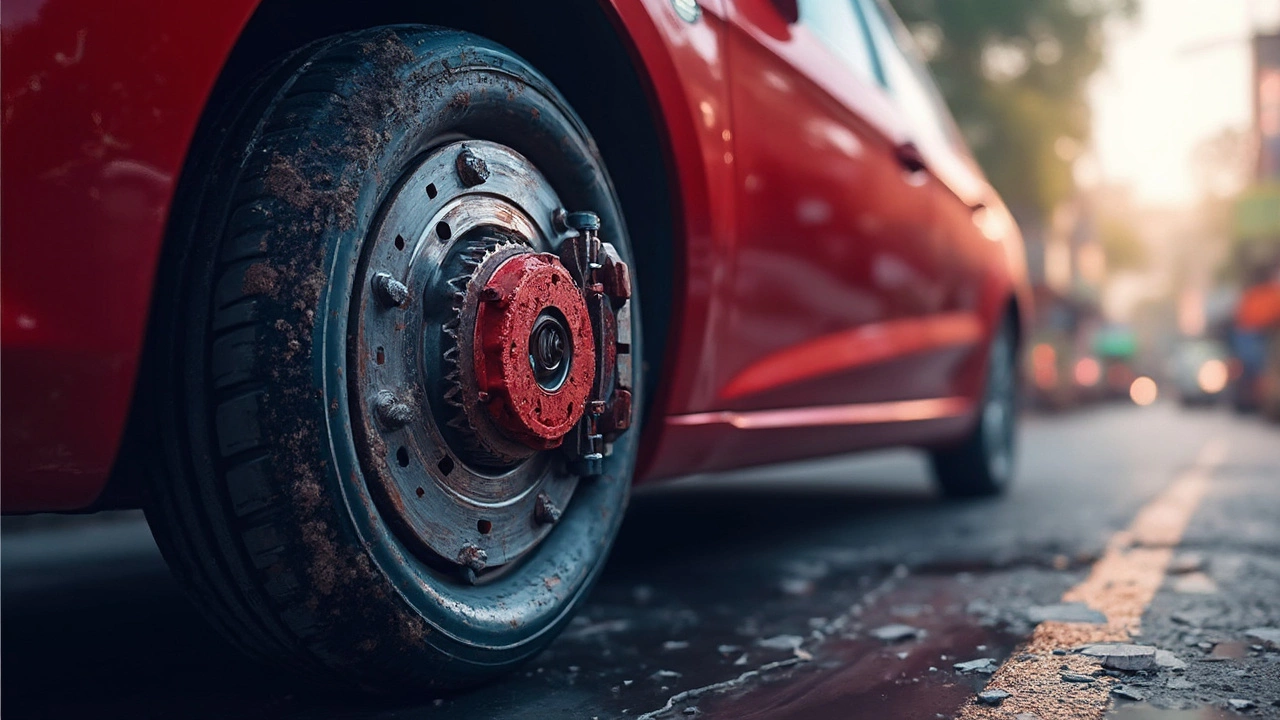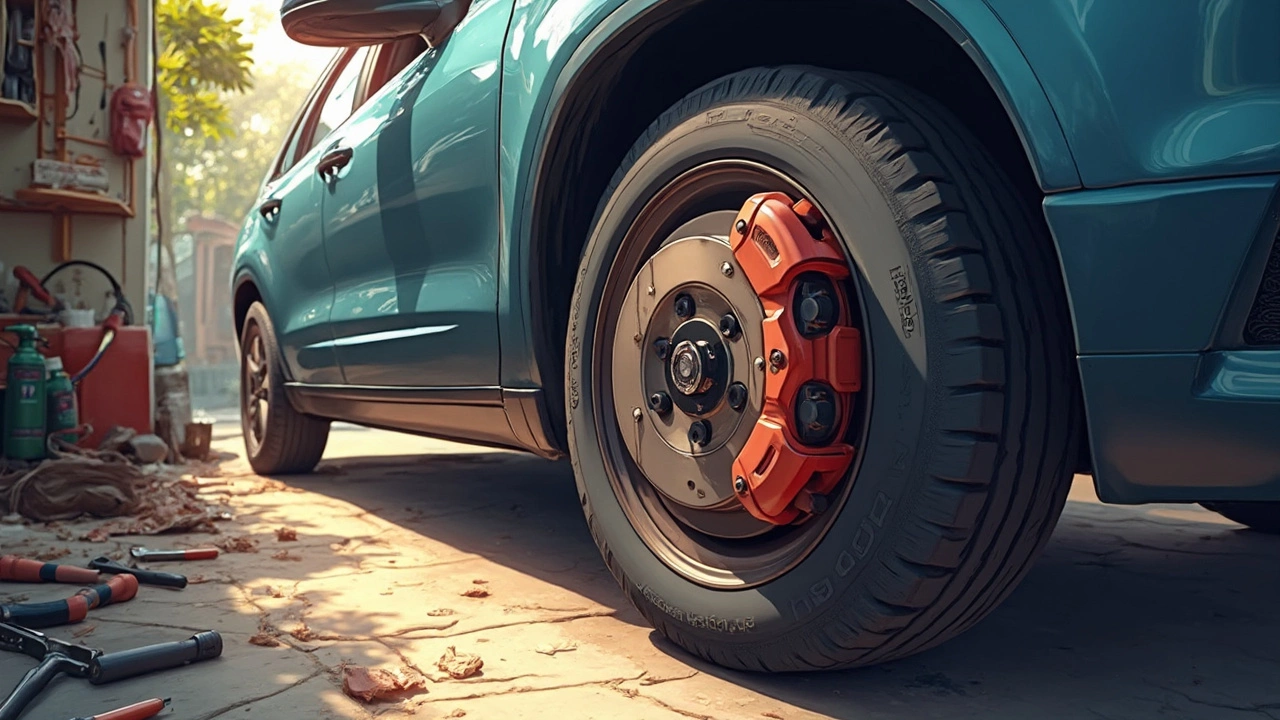Alright, let's talk about brake pads, those unsung heroes of car safety. You might be thinking: 'How long will five brake pads last me?' A quirky question, but here’s the deal—it depends on a bunch of things. Whether you're cruising the open highway or stuck in stop-and-go traffic, your braking habits, car type, and even the quality of your brake pads play a role in their lifespan.
Diving into specifics, most brake pads last anywhere between 30,000 to 70,000 miles. Quite a gap, huh? But it makes sense when you consider factors like your driving style, the conditions where you do most of your driving, and how often you hit the brakes. Aggressive driving? Yeah, you'll probably be swapping out pads more often.
- Understanding Brake Pads
- Factors Affecting Brake Pad Lifespan
- Signs Your Brake Pads Need Replacing
- Tips to Extend Brake Pad Life
Understanding Brake Pads
Alright, let's get into what really makes those wheels stop. Brake pads are crucial components of a vehicle's braking system. They're the parts that press against the brake rotor to create the friction needed to slow down or stop your car. But what are they made of? Typically, brake pads can be made from various materials, including semi-metallic, ceramic, and organic compounds, each with its own perks and drawbacks.
You might hear gearheads talking about brake pads made from ceramic materials. These pads are known for being quiet and producing less dust, but they might wear out the rotors faster. On the other hand, semi-metallic pads are durable and great at conducting heat, but they can be a bit noisy. Organic pads, often called non-asbestos organic (NAO), are made from materials like rubber and glass, making them softer but also quicker to wear out.
Now, if you're curious about how these brake pads actually function, it's all about the friction and heat. When you push that brake pedal, the system sends hydraulic pressure to the calipers, which then force the pads against the spinning rotor. This friction is what ultimately brings your car to a halt. The heat generated in this process is intense and requires the right choice of pad material to efficiently manage it without degrading quickly.
For a clearer picture, here's a quick comparison of the materials used in brake pads:
| Material | Pros | Cons |
|---|---|---|
| Ceramic | Quiet, less dust | Wears out rotors faster |
| Semi-Metallic | Durable, good heat conduction | Noisy |
| Organic | Softer, cheaper | Quicker to wear out |
Understanding these differences helps when it's time to choose new pads, keeping in mind what matters most to you—whether that's longevity, performance, or cost.
Factors Affecting Brake Pad Lifespan
Brake pads, those essential parts of your car's safety system, have a lifespan that can vary greatly. You might be wondering why this is the case. Well, it's mainly because a ton of different factors come into play. So, let’s break down what really impacts how long your brake pads will last. Trust me, it's more than just a single variable.
First off, let's talk driving habits. Are you one of those drivers who slams on the brakes at the last minute? Frequent sudden stops can wear out your brake pads quicker than you can say 'maintenance.' Gentle, gradual braking is the way to go if you're hoping to extend their life.
The type of vehicle you drive also matters. Heavy-duty trucks and SUVs typically demand more from their brakes compared to a lightweight sedan. The more the vehicle weighs, the harder the brake pads need to work. So if you're driving a big rig, keep a closer eye on those pads.
Let’s not forget about the roads you frequent. City driving with lots of start-and-stop traffic wears out brake pads faster than highway cruising. If you're constantly braking in gridlock, you might find yourself visiting the mechanic more often.
“Your car maintenance routine can significantly affect brake pad life,” says auto expert John McElroy. “Regular inspections and cleaning can prevent unnecessary wear.”
The climate plays a surprising role too. In regions with heavy rain or snow, brake pads might wear out faster due to the extra strain on braking systems. Plus, areas with salty winters can lead to faster corrosion.
Lastly, the quality and type of the brake pad material is crucial. Ceramic brake pads may last longer and resist wear better than semi-metallic ones, but they can cost a bit more. Investing in quality pads can save you money in the long run.
| Factor | Impact on Lifespan |
|---|---|
| Driving habits | High |
| Vehicle type | Medium |
| Road conditions | High |
| Climate | Medium |
| Brake pad quality | High |
Understanding these factors can help you make informed decisions, like adjusting your driving style or choosing the right brake pads, to keep your vehicle safe and your brake pads lasting longer.

Signs Your Brake Pads Need Replacing
Ever felt like your car is trying to send you secret messages? When it comes to your brake pads, it's not so much a riddle as it is understanding a few key signs.
First up, listen for a high-pitched squeal when you hit the brakes. That's usually a built-in wear indicator giving you a friendly nudge that it's time for new brake pads. Some folks might dismiss the noise, but ignoring it could lead to more dangerous and costly problems down the road.
Next, keep an eye out for a grinding sound. Unlike that squeal, this noise means metal on metal. If you've reached this stage, it’s a good idea not to let it slide any further. Not only will continuing to drive damage your rotors, but it could also end up being a hefty repair bill.
Feel like you need to push the pedal further to get your car to stop? That's another clear sign your brake pads might be worn. When braking feels sluggish or takes more pressure, it means your pads might be thinning out.
Check for a pulsing feel in the brake pedal or if your car is pulling to one side while braking. This might mean uneven wear on your brake pads.
- Listen for squealing sounds
- Don't ignore grinding noises
- Notice changes in brake performance
- Watch for warning lights on your dashboard
Don’t forget to check the brake pads themselves if you or a mechanic can get a look. Inspect the thickness; most should be about a quarter of an inch or thicker. If they’re thinner, it’s time to swap them out.
Lastly, if your car's dashboard lights up with a brake warning, pay attention to it. Those lights are there for a reason and checking them could save you from unexpected issues or expenses down the line.
Tips to Extend Brake Pad Life
So, you're eager to keep your brake pads in great shape and make them last longer? Smart move! Here are some down-to-earth tips to squeeze out some extra life from your brakes, saving both money and hassle in the long run.
First, try to anticipate your stops. When you see a red light or heavy traffic ahead, ease off the gas and coast to slow down. This cuts down on those abrupt stops that wear out brake pads fast. In general, the gentler you are on the brakes, the longer they’ll last.
Next, think about lightening your car’s load. Excess weight is a sneaky culprit that makes your brakes work overtime. Clean out the trunk and ditch any heavy gear you don’t need on a daily basis.
Regular maintenance is another key player. Have your brakes checked during routine services. Mechanics can catch early signs of wear and tear, like uneven brake pad thinning, which might not be on your radar yet.
- Rotate tires regularly to ensure even brake distribution.
- Flush brake fluid as recommended by the vehicle manufacturer to keep your brakes performing at their best.
- Consider upgrading to high-quality brake pads tailored for your driving conditions; they might cost more upfront but save in the long term.
Lastly, keep your ears peeled for unusual noises. Squealing, grinding, or clicking sounds often signal it’s time for some brake TLC. It’s cheaper to fix problems early rather than wait for them to get worse.
Stick to these tips, and you’ll not only extend the life of your brake pads but also drive a safer car. And hey, who doesn’t like that?




